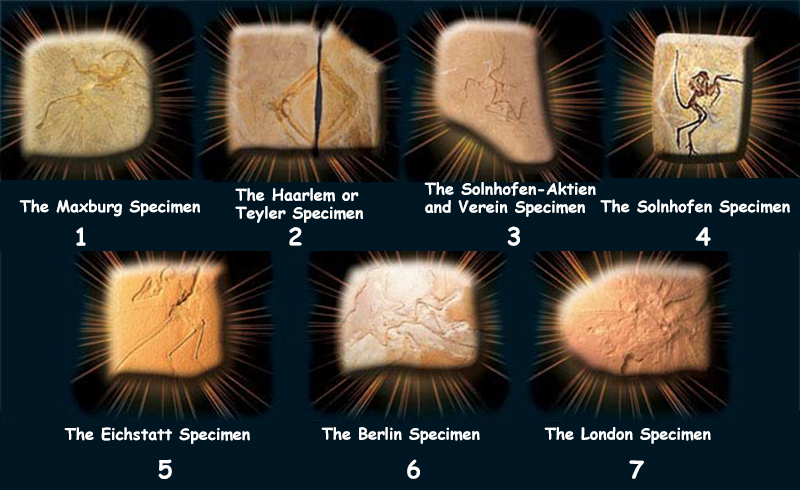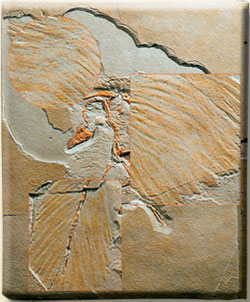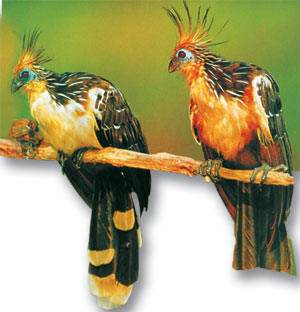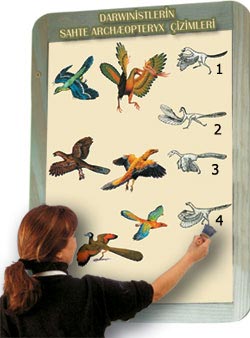After Darwin published The Origin of Species in 1859, the search began for intermediate forms to verify his claims. Darwinians regarded the first Archaeopteryx fossil, found in the Solnhofen Limestone in Bavaria in 1861, as evidence that would prove their theory valid. The skeleton of Archaeopteryx (which name, in Latin, means "wing left over from ancient times") was placed in a bank vault for protection. The importance of this fossil, 30 centimeters (11.811 inches) in length, the size of a modern-day crow, stemmed from its features, which Darwinists alleged belonged to both birds and reptiles. With great excitement—and bias—they portrayed the fossil as an intermediate form. It took its place in many museum exhibitions and textbooks as definitive proof of evolution. Meanwhile, criticisms regarding the fossils, as well as the inconsistencies that emerged, were all ignored.
A number of features peculiar to Archaeopteryx led evolutionists to interpret it as a transitional species between reptiles and birds. It was suggested that this 150-million-year-old fossil bore the half-reptile characteristics of an extinct species that had lived long before birds. Archaeopteryx's feathered claws on its arms, the teeth in its beak and bony, reptile-like tail led to its being interpreted as evidence of the theory of evolution. On account of the similarities, Thomas Huxley, one of Darwin's supporters, first proposed in 1870 the idea that Archaeopteryx was descended from dinosaurs. 112
According to the theory of evolution, the forelegs of certain small dinosaurs called Velociraptors or Dromaeosaurs—a group of small and medium-sized carnivorous dinosaurs that lived 144 to 66.4 million years ago—had gradually developed into wings as the animals leaped onto their prey from high branches. Archaeopteryx was the first species to branch off from its alleged dinosaur ancestors and begin to fly. This scenario can be found in just about every evolutionist publication. In fact, however, recent examinations of other Archaeopteryx fossils have shown that this creature is very definitely no intermediate form, but merely an extinct species of bird with a few features that distinguish it from modern-day species. The scientific world today agrees that Archaeopteryx possessed a skeleton, feather structure and flight muscles identical to those of present-day birds. In addition, scientific examination has proved that with its breastbone 113 and asymmetric feather structure,114 Archaeopteryx was fully capable of flight. In contrast to general evolutionist claims, its possessing teeth does not indicate it to have been a dinosaur. 115
In short, Archaeopteryx cannot be called an intermediate form on the basis of a few unique features. In particular, the seventh Archaeopteryx fossil, found in 1992, totally demolished evolutionist claims based on its similarity to reptiles. The scientific writer Richard Milton touched on the invalidity of the claims regarding Archaeopteryx:
Although it is certain that Archaeopteryx is an important fossil, it is hard at this moment to say what that importance actually is. Even more importantly, it is impossible for Darwinists to suggest that it supports natural selection accompanied by a random mechanism of genetic mutation. Archaeopteryx constitutes no evidence for these mechanisms, because it is a completely isolated fossil in the fossil record with no known direct ancestor or lineage, just like Eohippus. 116
Archæopteryx Fossils |
 |
| Seven examples of fossils belonging to the species Archaeopteryx have been discovered (not including fossils of individual feathers), as follows |
Since Archaeopteryx is acknowledged to not represent any intermediate form, many evolutionists today agree on the need for new evidence. Alan Feduccia expresses the erroneous nature of the evolutionist claims regarding Archaeopteryx:
Paleontologists have tried to turn Archaeopteryx into an earth-bounded, feathered dinosaur. But it's not. It is a bird, a perching bird. And no amount of "paleobabble" is going to change that. 117
Despite being an evolutionist, the Yale University professor of geology John H. Ostrom agrees that these claims lack proof:
Zdenek Burian re-organized pre-Archaeopteryx step in the evolution of bird flight which is usually named pro-avis. There is no fossil evidence of pro-avis at all. 118
Colin Patterson, another evolutionist scientist, also says that these claims are very far from being scientific:
Is Archaeopteryx the ancestor of all birds? Perhaps yes, perhaps no: there is no way of answering the question. It is easy enough to make up stories of how one form gave rise to another, and to find reasons why the stages should be favoured by natural selection. But such stories are not a part of science, for there is no way of putting them to the test. 119
For the reasons, which we shall examine in detail in due course, the thesis that Archaeopteryx was a primitive bird is false. Yet this fossil is of indispensable importance to Darwinists, not because it constitutes evidence for any process of evolution, but because it generates easy speculation. On every possible occasion, the fossil is brought up as if it represented significant evidence, despite the facts being proven time and again. No intermediate forms, the basic claim of the theory of evolution, have ever been found. The removal of Archaeopteryx, looked on as literally the only specimen that evolutionists imagined they could deploy, would deal the theory a severe blow. Therefore, the continued depiction of Archaeopteryx as evidence is a dogmatic, rather than scientific.
Ever since the 19th century, evolutionists have been speculating about Archaeopteryx. The teeth in its mouth, the claw-like talons in its wings and long tail led to the fossil being compared to reptiles. Many evolutionists have described it as a "primitive bird" and have even claimed it is closer to reptiles than to birds. Yet in fact, this animal was definitely not an intermediate form. On the contrary, its skeleton and feathers were ideally suited to flight. Those features compared to those of reptiles have also been found in birds that lived in the past, and even in other birds still living today.
Alan Feduccia, subscribes to this view and opposes the idea that Archaeopteryx is the primitive ancestor of birds:120 "Most recent workers who have studied various anatomical features of Archaeopteryx have found the creature to be much more birdlike than previously imagined. The resemblance of Archaeopteryx to theropod dinosaurs has been grossly overestimated." 121
Archaeopteryx possesses a number of features that differ from those in modern birds, yet its characteristics show it to have been a true bird. The fact that Archaeopteryx possesses a number of unique features does not show it to be an intermediate form. The proofs that Archaeopteryx is merely an extinct species of bird—and not a half-dinosaur, half-bird—can be briefly summarized:
Archæopteryx is an Extinct Bird. Not an Intermediate Form |
 |
| Archaeopteryx has a great many features in common with present-day birds: |
Dinosaurs possess no clavicula, or wishbone, though Archaeopteryx, like all other birds, possesses a clavicula. The anatomist David Menton refers to its wishbone in these terms:
Archaeopteryx has a robust wishbone [furcula]. Some recent fascinating studies using moving X-rays of birds as they fly show how the shoulder girdle has to be flexible to cope with the incredible forces of the power-stroke in flight. You can actually see the wishbone flex with each wing-beat. 122
Until the 1990s, the fact that Archaeopteryx lacked a sternum, or breastbone, was viewed as the most important evidence that it could not fly. (The breastbone, to which are attached the muscles necessary for flight, is found in front of the rib cage. This bone exists in all modern birds, flying or flightless, and even in bats, mammals that belong to a completely different order.)
However, the seventh Archaeopteryx fossil, discovered in 1992, disproved this argument. That fossil did contain a sternum, which evolutionists had for so long imagined did not exist. 123 This newly discovered fossil was described in Nature magazine:
The recently discovered seventh specimen of Archaeopteryx preserves a partial, rectangular sternum, long suspected but never previously documented. This attests to its strong flight muscles, but its capacity for long flights is questionable. 124
Alan Feduccia comments:
In conclusion, the robust furcula of Archæopteryx would have provided a suitable point of origin for a well developed pectoralis muscle . . . thus the main evidence for Archæopteryx having been a terrestrial, cursorial predator is invalidated. There is nothing in the structure of the pectoral girdle of Archæopteryx that would preclude its having been a powered flier. 125
This discovery completely undermined any claims that Archaeopteryx was a flightless half-bird.
With its Asyymetric Feather structure, Archaeopteryz is İdentical to Present-Day Birds |
 |
| One of the most important pieces of evidence that Archaeopteryx was truly able to fly is the structure of its feathers— an asymmetric structure, identical to that in present-day birds. |
One of the most important evidence that Archaeopteryx was capable of perfect flight is the asymmetrical structure of its feathers, identical to those in modern birds. As the well- known paleontologist Carl O. Dunbar stated, "Because of its feathers, [Archaeopteryx is] distinctly to be classed as a bird."126 The paleontologist Robert Carroll issued the following statement:
The geometry of the flight feathers of Archaeopteryx is identical with that of modern flying birds, whereas nonflying birds have symmetrical feathers. The way in which the feathers are arranged on the wing also falls within the range of modern birds. . . According to Van Tyne and Berger, the relative size and shape of the wing of Archaeopteryx are similar to that of birds that move through restricted openings in vegetation, such as gallinaceous birds, doves, woodcocks, woodpeckers, and most passerine birds. . . The flight feathers have been in stasis for at least 150 million years. . . . 127
Alan Feduccia also points to this asymmetric structure in stating that Archaeopteryx was a flying bird:
The significance of asymmetrical features is that they indicate the capability of flying; nonflying birds such as the ostrich and emu have symmetrical [feathered] wings. 128
After emphasizing the complexity in Archaeopteryx's feathers, the anatomist David Menton draws attention to the deceptive nature of some evolutionists' attempts to claim the animal was partly scaled:
...The feathers are not just simply applied to the surface of the bird. Where they are attached to bone by ligaments, we see tiny 'bumps.' So in Archaeopteryx, the primary and secondary wing feathers are attached to the 'hand' and ulna, respectively. And the feathers on the tail are actually minutely attached to each of the 20 vertebrae. There are also a lot of small feathers on the legs and body of this bird, and there is compelling evidence that the head was covered with feathers too. However, when you see pictures of Archaeopteryx or its imaginary ancestors, it's quite common for artists to show a scaly head. 129
On the basis of certain features in Archaeopteryx's feather structure, some evolutionists have claimed that the creature was a dinosaur that climbed into the trees and then glided down, or soon took off by beating its wings. In fact, however, Archaeopteryx had a perfect structure and asymmetrical feathers, as can be seen from all the remains it has left behind.
The shape, structure, and general proportions of Archaeopteryx's wings are identical to those of modern-day birds. The fact that its wing structure has remained unchanged for 150 million years, since the Jurassic period, in other birds shows that Archaeopteryx's wings were created for flight. Those who claim that Archaeopteryx was unable to fly cannot explain that asymmetric structure. 130
With its muscles and feathers ideally suited to flight, this was a full-fledged flying bird. No fossil of a half-reptile, half-bird that lived earlier has ever been unearthed. Therefore, with its structure so similar to that of modern-day birds, Archaeopteryx presents significant evidence against the theory of evolution.
Evolutionists use these claws as evidence that Archaeopteryx is an intermediate form, that it evolved from dinosaurs. In fact, however, this feature shows no relationship between this creature and reptiles. Indeed, two modern-day birds, Touraco corythaix and Opisthocomus hoazin, have talons that they use to cling onto branches. These two species are full-fledged birds, with no reptilian characteristics. Therefore, the claim that the talons in the Archaeopteryx wing mean it's an intermediate form is invalid.
In 1983, specimens of several species with talons in their wings, belonging to nine separate bird families, were displayed in the British Natural History Museum. 131 Clawed wings do not, therefore, make Archaeopteryx an intermediate form, since this feature also belongs to some birds alive today.
 |
| The hoatzin bird of modern-day Venezuela possesses clawed wings, just like Archaeopteryx. Several other bird species bear clawed wings, which demolishes the thesis that clawed wings are an intermediate features. |
One of the main "intermediate form" features that evolutionist biologists point to is the teeth in Archaeopteryx's jaw. But this does not actually show any relationship between this bird and earlier reptiles. Evolutionists are mistaken in suggesting that these teeth are a reptilian feature, because teeth are not a reptilian characteristic. Some modern-day reptiles have teeth, while others (such as turtles) do not. Even more importantly, Archaeopteryx was not the only toothed bird. Such birds are extinct today, but the fossil record contains a separate group of toothed birds that lived both at the same time as Archaeopteryx and afterwards—and indeed until recent times.
Dr. Carl Wieland comments:
Archaeopteryx was not the only fossil bird to have had grasping teeth. Some fossil birds had teeth, some didn't. But how can teeth prove a relationship to reptiles, when many reptiles don't have teeth? Crocodiles are really the only group of reptiles that consistently have very well-developed teeth. And of course, even some mammals have teeth and some don't. 132
One very important fact, often ignored, is that the dental structure of Archaeopteryx and other toothed birds is very different from that of dinosaurs. According to measurements carried by such well-known ornithologists as L. D. Martin, J. D. Stewart and K. N. Whetstone, the teeth in Archaeopteryx and other toothed birds have flat surfaces and have broad roots. Yet the tooth surfaces of theropod dinosaurs, alleged to be the ancestors of these birds, are serrated like saws, and their roots are narrow.133 Studies by such anatomists as S. Tarsitano, M. K. Hecht and A. D. Walker have revealed that some of the similarities suggested between Archaeopteryx and dinosaurs are entirely due to misinterpretation. 134
All this goes to show that Archaeopteryx was not an intermediate form, but merely belongs to a separate classification of toothed birds. Seeking to establish a relationship between this creature and theropod dinosaurs is highly unscientific.
It has been claimed that Archaeopteryx's jawbone resembles that of dinosaurs, but during examinations by Haubitz and his team, using computer tomography, revealed that its jawbone is in fact identical to those of modern birds.135 The movement of the jaw is another important piece of evidence that undermines evolutionist claims. In most vertebrates, including reptiles, only the lower jaw is mobile, while in birds, including Archaeopteryx, the upper jaw also moves.
Researchers compared the Solnhofen feathers and the asymmetry of Archaeopteryx's flight feathers with those of modern-day flying and flightless birds.1 They discovered that the average asymmetry in Archaeopteryx feathers was 1.25—lower than that in modern-day flying birds, but higher than that in present-day flightless birds. The isolated feather displayed an asymmetry of 2.2, roughly that of modern-day fully flying birds. In addition, Archaeopteryx's claws were compared with more than 500 present-day species. The research showed that Archaeopteryx's hind feet fell into the zone of arboreal birds, and the middle claws were at the level of the most powerful arboreal birds.2 They therefore concluded that Archaeopteryx was a fully-fledged arboreal bird.
Another blow to the evolutionist thesis comes from Archaeopteryx's finger structure. Development of the forearm bones during the embryonic process is completely different in birds and theropod dinosaurs.
The Conjectural Drawing of Darwinists |
 |
| (1) Changed in 1975 after the American paleontologist Robert T Bakker. |
Theropod dinosaurs' "hands" develop from the first, second and third finger bones, and the wings of birds from the second, third and fourth finger bones. This is an important distinction between dinosaurs and birds, as was noted in a 1997 article in Science magazine:
In reality, there is no easy solution to this question of bird origins. ...The problem for this view is the long evolutionary gap, with no convincing intermediates. What we need is a proto-Archaeopteryx find to complement the numerous post-Archaeopteryx finds that are now being made. But for the time being this important developmental evidence that birds have a II-III-IV digital formula, unlike the dinosaurs' I-II-III, is the most important barrier to belief in the dinosaur-origin orthodoxy. 136
J. Richard Hinchliffe, of the University of Wales Institute of Biological Sciences, reached this conclusion by using the modern isotopic technique on embryos. While birds' wings develop from the second, third and fourth fingers, those of theropod dinosaurs developed from the first, second and third. This is a major problem for those who maintain the relationship between Archaeopteryx and dinosaurs. 137
Hinchliffe's research and observations were reported in the same Science article:
Doubts about homology between theropod and bird digits remind us of some of the other problems in the "dinosaur-origin" hypothesis. These include the following:
◉ The much smaller theropod forelimb (relative to body size) in comparison with the Archaeopteryx wing. Such small limbs are not convincing as proto-wings for a ground-up origin of flight in the relatively heavy dinosaurs.
◉ The rarity in theropods of the semilunate wrist bone, known in only four species (including Deinonychus). Most theropods have relatively large numbers of wrist elements, difficult to homologize with those of Archaeopteryx. 138
In addition, such well known ornithologists as L. D. Martin, J. D. Stewart and K. N. Whetstone compared the wrist bones of Archaeopteryx and dinosaurs and revealed that there was no similarity between them.139
During an interview, the anatomist David Menton responded to the question of whether Archaeopteryx's feet indicated that it was a terrestrial, running dinosaur:
No. Archaeopteryx, along with all perching birds, has what is called a grasping hallux, or hind toe, pointing backwards. Rearward-facing toes may be found in some of the dinosaurs, but not a true grasping hallux with curved claws for perching. 140
Interpretations that suggest Archaeopteryx's skeletal structure caused it to stoop forward—a characteristic of dinosaurs—are not confirmed by scientific findings. A. D. Walker has stated that interpretations along these lines are false and that Archaeopteryx's skeletal structure, like a bird's, predisposed it to lean backwards. 141
Dr. David refers to the avian skeletal structure:
There are also design similarities between reptiles, mammals and living birds too. Birds have a distinctive, specialized skeleton because, as one distinguished evolutionist who is also an ornithologist once said, "Birds are formed to fly." So was Archaeopteryx. 142
Darwinism is Philosophy Based on Illusions and Felsehoods. Not Hard Science |
 |
| These different representations of Archaeopteryx based on a single fossil show how influential imaginations of evolutionist scientists can be in interpreting fossil remains. These deceptive illustrations are of no scientific value, but are portrayed as so-called evidence to influence the public. However, these methods reveal that Darwinism is not a science. There are many branches of science, but Darwinism is merely an illusory philosophy. |
"Early Bird Had the Brains to Fly", an article in the 6 August, 2004, edition of Scientific American, stated that Archaeopteryx possessed the special nervous system mechanisms needed for flight. When paleontologists discovered the first fossils belonging to this species in 1861, they were thought to represent evidence for the theory of evolution, which had been proposed less than a decade before. But scientific research gradually revealed that this claim was false.
Timothy B. Rowe from the University of Texas and his team began researching flight characteristics in a 147-million-year-old Archaeopteryx fossil. Their three-dimensional investigations of the skull, using X-ray imaging, revealed a well-developed visual center and inner ear canals closely resembled those of flying birds. These structures enable the balancing abilities that are essential for flight.
Lawrence M. Witmer of Ohio University says, "We used to think that [only]feathers made the bird," and goes on to say, "you have to put in a big computer to fly."143 Scientists using advanced techniques to study the Jurassic-period Archaeopteryx skull also stated in their research, published in Nature magazine, that Archaeopteryx's brain had similar structures for flight and balance as do modern-day birds—and that this 150-million-year-old bird could definitely fly. 144
In the words of Dr. Angela Milner from London's Natural History Museum, Archaeopteryx's brain is "identical" to that of birds. She reconstructed its skull's three-dimensional structure using computer tomography and the inner brain via computer. "We were fully expecting to find a dinosaur-like brain," she stated. "Instead, it was completely bird-like." Her study revealed that Archaeopteryx's brain structure was very close to that of modern flying birds. Its inner ear had well-developed canals used for balance, and larger optic lobes for vision. Both structures are utterly essential for efficient flight. Dr. Milner added: "The brain scan basically showed that the Archaeopteryx had all of the structures that allow birds to fly." 145
The most important evidence that Archaeopteryx cannot be a link between dinosaurs and birds is that theropod dinosaur fossils belong to a far later period than Archaeopteryx. The fossil dinosaurs claimed to be the ancestors of birds actually lived in the Cretaceous Period, some 75 million years after Archaeopteryx, showing that any such transition is purely imaginary.
This incompatible timing deals a lethal blow to evolutionist claims. In his book Icons of Evolution, the American biologist Jonathan Wells emphasizes that Archaeopteryx has literally become an emblem of evolution, even though all evidence clearly shows that the creature could not have been birds' primitive ancestor. According to Wells, one indication of this is that the theropod dinosaurs, depicted as the ancestors of Archaeopteryx, actually appear later in the fossil record. 146
Richard Hinchliffe of the University of Wales Institute of Biological Sciences touches on this subject in an article in Science magazine:
The most theropod dinosaurs and in particular, the birdlike dromaeosaurs are all very much later in the fossil record than Archæopteryx. 147
Another important proof that Archaeopteryx cannot be an intermediate form is the finding of fossilized bird fossils that lived close to it in time. All this shows that Archaeopteryx is not an intermediate form, but of a classification that can be termed toothed birds—and it is totally illogical to link this creature to theropod dinosaurs. In an article titled "Demise of the 'Birds are Dinosaurs' Theory," the American biologist Richard L. Deem says this about Archaeopteryx:
The results of the recent studies show that the hands of the theropod dinosaurs are derived from digits I, II, and III, whereas the wings of birds, although they look alike in terms of structure, are derived from digits II, III, and IV. . . . There are other problems with the "birds are dinosaurs" theory. The theropod forelimb is much smaller (relative to body size) than that of Archaeopteryx. The small "proto-wing" of the theropod is not very convincing, especially considering the rather hefty weight of these dinosaurs. The vast majority of the theropod lack the semilunate wrist bone, and have a large number of other wrist elements which have no homology to the bones of Archaeopteryx. In addition, in almost all theropods, nerve V1 exits the braincase out the side, along with several other nerves, whereas in birds, it exits out the front of the braincase, though its own hole. There is also the minor problem that the vast majority of the theropods appeared after the appearance of Archaeopteryx. 148
All this information proves that Archaeopteryx and birds resembling it are not intermediate forms. Fossils show that birds did not evolve from reptiles, or any other group. On the contrary, fossils prove that birds appeared suddenly, with all their unique features.
As you have seen, Archaeopteryx's manifest characteristics show that it was a bird. Furthermore, it has no features to prevent it from being very good at flying.149 That Archaeopteryx's organs bear no similarity to those of theropod dinosaurs is reported in the magazine Science:
No dinosaur had an embryonic thumb, though all birds have them, on the feet they use for landing … All dinosaurs have saw-edged teeth, with razor-like molars. Confuciosornis (a 142-million-year-old bird fossil) has no teeth. Although Archaeopteryx has teeth, they are not saw-edged, but are arranged in rows like nails. There are two wide spaces at the back of all dinosaur skulls. Birds do not have these. There is no link between them at all, not even down to the finest detail. 150
All the scientific findings reveal that Archaeopteryx cannot have been an intermediate form between dinosaurs and birds, and also invalidate evolutionist claims on the subject. Dr. Michael Denton comments on why the Archaeopteryx is not an intermediate form and how evolutionists have distorted some of the bird's characteristics:
In Eichstátt, Germany, in 1984 there was a major meeting of scientists who specialize in bird evolution, the International Archaeopteryx Conference. They disagreed on just about anything that was covered there on this creature, but there was very broad agreement on the belief that Archaeopteryx was a true bird. . . Did that mean that really they didn't think it was a transitional pre-bird? . . . Well, it's kind of interesting that they found it necessary to draft the following statement. . . So you can see they were acutely aware that their deliberations might lead some to wonder whether, in fact, Archaeopteryx had anything to say about evolution, so they all did sign this. If, of course, it's a true bird, it is not the half-way, half-reptile, half-bird like we've often heard.151
In short, the thesis of bird evolution is not consistent with biological or paleontological evidence, but is a fictitious, unrealistic claim stemming from Darwinist preconceptions. The subject of bird evolution, which some experts speak of as if it were scientific fact, is a myth kept alive for philosophical reasons. The truth revealed by science is that the flawless creation in birds is the work of an infinite wisdom—that they were created by Almighty Allah.
112. Richard Milton, Shattering the Myths of Darwinism, Rochester, Vermont: Park Street Press, , 1997, p. 1. 
113. Nature, Vol. 382, 1 August 1996, p. 401. 
114. Carl O. Dunbar, Historical Geology, New York: John Wiley and Sons, 1961, p. 310. 
115. Richard L. Deem, "Demise of the 'Birds are Dinosaurs''Theory;" http://www.direct.ca/trinity/dinobird.htm 
116. Richard Milton, "Son Tartışmalar Işığında Darwinizm'in Mitleri, [Shattering the Myths of Darwinism] " Gelenek Publishing House, September 2003, translated by: İbrahim Kapaklıkaya, p. 139. 
117. Alan Feduccia, "Archæopteryx: Early Bird Catches a Can of Worms," Science, Vol. 259, Issue. 5096, 5 February 1993, pp. 764-765. 
118. John Ostrom, "Bird Flight: How Did It Begin?", American Scientist, No. 67, January-February 1979, p. 47. 
119. Colin Patterson, Darwin's Enigma: Fossils and Other Problems, El Cajon, CA: Master Book Publishers, , 4. Edition, 1988, p. 89 (Emphasis added). 
120. Alan Feduccia, "Birds are Dinosaurs: Simple Answer to a Complex Problem," The Auk, Vol. 119, No. 4, October 2002, pp. 1187-1201. 
121. Alan Feduccia, The Origin and Evolution of Birds, Yale University Press, 1999, p. 81 (Emphasis added). 
122. "Bird Evolution Flies out the Window: An anatomist talks about Archæopteryx": David Menton with Carl Wieland, Creation Ex Nihilo, Vol. 16, No. 4, July-August 1994, pp. 16-19. 
123. Nature, Vol. 382, 1 August 1996, p. 401. 
125. Storrs L. Olson, Alan Feduccia, "Flight Capability and the Pectoral Girdle of Archæopteryx," Nature, No. 278, 15 March 1979, p. 248. 
126. Carl O. Dunbar, Historical Geology, New York: John Wiley and Sons, 1961, p. 310. 
127. Robert L. Carroll, Patterns and Processes of Vertebrate Evolution, Cambridge University Press, 1997, pp. 280-81. 
128. E. Olsen, A. Feduccia, "Flight Capability and the Pectoral Girdle of Archæopteryx," Nature, 1979, p. 248. 
129. "Bird Evolution Flies out the Window," pp. 16-19. 
130. Alan Feduccia, Harrison B. Tordoff, "Feathers of Archæopteryx: Asymmetric Vanes Indicate Aerodynamic Function," Science, Vol. 203, 9 March 1979, p. 1021. 
131. Luther D. Sunderland, Darwin's Enigma, Master Book Publishers, , 1988, pp. 74-75. 
132. "Bird Evolution Flies out the Window," pp. 16-19. 
133. L. D. Martin, J. D. Stewart, K. N. Whetstone, The Auk, Vol. 98, 1980, p. 86. 
134. S. Tarsitano, M. K. Hecht, Zoological Journal of the Linnaean Society, Vol. 69, 1985, p. 178; A. D. Walker, Geological Magazine, Vol. 177, 1980, p. 595. 
135. B. Haubitz, M. Prokop, W. Döhring, J. H. Ostrom, P. Welinhofer, Paleobiology, Vol. 14, No. 2, 1988, p. 206. 
136. Richard Hinchliffe, "The Forward March of the Bird-Dinosaurs Halted?," Science, Vol. 278, 24 October 1997, pp. 596-597. 
139. L. D. Martin, J. D. Stewart, K. N. Whetstone, The Auk, Vol. 98, 1980, p. 86; L. D. Martin, "Origins of Higher Groups of Tetrapods,", Ithaca, New York: Comstock Publishing Association, 1991, pp. 485, 540. 
140. "Bird Evolution Flies out the Window." 
141. A. D. Walker, Geological Magazine, Vol. 117, 1980, p. 595. 
142. "Bird Evolution Flies out the Window" 
143. "Early Bird Had the Brains to Fly," Scientific American, Science News, 5 August 2004. 
144. Jacqueline Ali, "Bird brain reveals flight secrets," BBC News Online; http://news.bbc. co.uk/2/hi/science/nature/3535272.stm 
146. Jonathan Wells, Icons of Evolution, Regnery Publishing, 2000, p. 117. 
147. Richard Hinchliffe, "The Forward March of the Bird-Dinosaurs Halted?," Science, Vol 278, No. 5338, 24 October 1997, pp.. 596-597. 
148. Richard L. Deem, "Demise of the 'Birds are Dinosaurs' Theory;" http://www.yfiles.com/ dinobird2.html (Emphasis added). 
149. S. L. Olson, Alan Feduccia, Nature, Vol. 278, 1979, p. 247. 
150. "The Oldest Fossil Bird: A Rival for Archæopteryx," Science, Vol. 199, 20 January 1978, p. 284. 